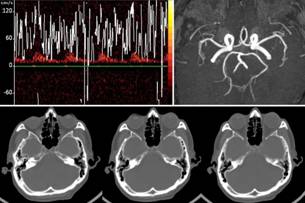Images in Neurology
Transcranial Doppler (TCD) is a non-invasive procedure that is increasingly used for diagnostic and prognostic purposes in patients with an acute stroke (1). In addition, TCD enhances the effect of thrombolysis by exposing thrombi surfaces to circulating rTPA(2). However, insonation problems through acoustic windows limit the diagnostic efficiency of TCD. Accurate prediction of individuals who are more prone to present such problems may save valuable time for decision making on thrombolysis. Increased thickness of temporal bones and the presence of exuberant cancellous bone (diploe) account for the high rate of TCD failures among women, older individuals and people of different ethnic groups (3)(4). In addition, air may also interfere with proper assessment of signal flows from intracranial arteries. Aberrant pneumatization of temporal squamas were recognized as responsible for TCD failures in only one study(5), but no further attention has been given to this condition, which is thought to be more common in persons with recurrent ear infections, nasal deflections or in those exposed to frequent high altitude travel or Valsalva maneuvers(6). Routine evaluation of bone window on CT scans may help to visualize aberrant pneumatization of the temporal squama and to identify individuals who are not candidates for TCD. (Figure 1)

Figure 1 Upper panel: Poor trans-temporal windows insonation of the left middle cerebral artery (right MCA was not visualized) during TCD in a 70-year-old man with patent MCAs as demonstrated by magnetic resonance angiography. Lower panel: CT with bone window shows extensive pneumatization of temporal squamas, which extended more than 1cm anteriorly to the insertion of the pinna.














